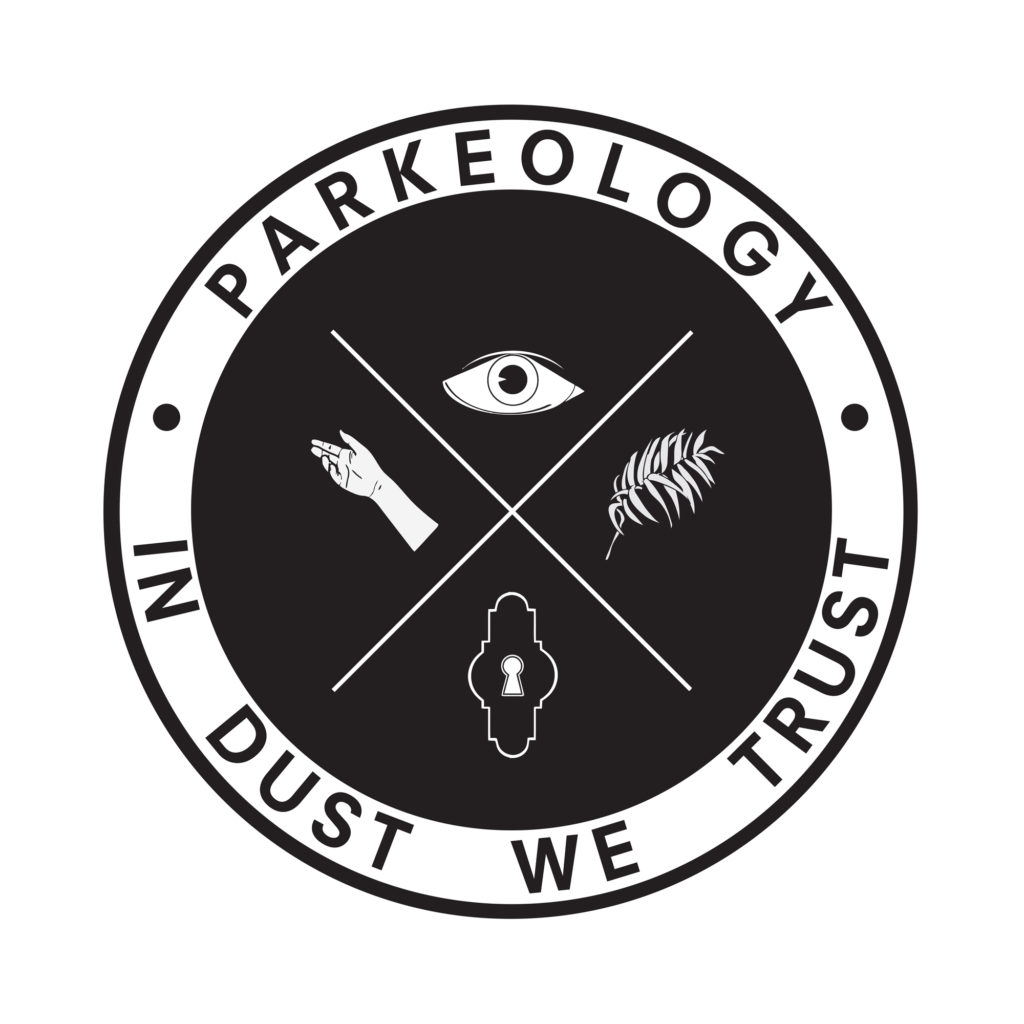Parkeology: In Dust We Trust
Parkeology is a public art and webtv series directed by Kate Clark that excavates sites, stories and senses from urban parks. Featuring Balboa Park, in San Diego, California, Season I hosted five events exploring popular and obscure locations exposing the secret lives of artifacts, closeted LGBT histories, nudist colony remnants, and reimagined organ pavilions. True to our motto, “In Dust We Trust”, each project began by sifting through boxes, snooping in basements, and following up on another kind of dirt: gossip. Over time, these fragments grew into collaborative events and their respective scripts, scores, costumes, objects, and media. Parkeology partners with institutions and people to host time-based events chronicled by Channel Parkeology, directed by Ren Ebel, a webtv series, and ParkCast, a podcast series directed by Parker Bray.
Like many developing cities, San Diego’s algorithm of urban growth continues to accelerate. What only 167 years ago was both indigenous harvest territory and Mexican grazing land is now 1,400 acres of curated megafauna, miniature train systems, and freezers of artifacts. Along with whetting utopian tourist appetites, Balboa Park is also ground zero for many violences, social experiments, and struggles.
From an artists’ perspective, we think about this history of land use as a form of mark making. And no mark making is neutral. If you are a subject that somehow falls outside of this spectrum of normative design- there is a higher chance your physical imprint will have less staying power. Instead of hunting for clues that point to habitualized activity, we highlight and foster moments of experimentation, rupture, and even dischord- not as a historic recovery project- but to pose alternative ways of imagining how we treat the commons we have inherited and are producing. As parkeologists, our job is to create frameworks for people to relate to familiar spaces as if they are strange again. We scratch below the stucco, put our ear to it, and try to feel it from new angles.
There is much more to say, and hopefully the conversations continue!
Below is a brief description of each project, along with the corresponding Channel Parkeology episode links. To learn more, visit: www.parkeology.org
All Parkeology programming is free, with support from the National Endowment for the Arts, the Project for Public Spaces, the San Diego Foundation, the California Arts Council, and The San Diego Art Institute.
I. Untracked: Beneath the Scenes at the SDMRM
For it’s inaugural event, Parkeology featured one of the most democratic spaces in San Diego: the San Diego Model Railroad Museum. Intimate tours were lead by an elected guide of the four model railroad clubs. Visitors experienced how each individually organized club builds and operates their landscapes and railways under a unique order of esthetics, scale, and culture.
II. Facing Artifacts: Casting and Collecting Profiles at the San Diego Museum of Man
In 1915, Museum of Man archivists worked with the Smithsonian to acquire life casts of members of Native American tribes, as well as many other racial “types.” These casts were exhibited to the public for the Panama California Exposition as an illustration of the progress of man. Parkeology revisited these difficult origins of physical anthropology, a science that is still in practice today. For one day, a life casting station was headquartered in the museum rotunda. Participants sat for 30 minutes with a lead Parkeologist and had their features transformed into a museum artifact.
III. Queen’s Circle: Cruising Oral Histories of Balboa Park
In collaboration with Lambda LGBT Archives edited sound interviews from those who participated in, surveilled, or managed gay cruising culture in Balboa Park became the fodder for an evening of storytelling. These recorded tales were played in parked cars in a popular cruising location: the “Fruit Loop.”
IV. The Naked Truth: The Rise and Fall of America’s Only Public Nudist Colony in Four Acts
For the 1935-36 California-Pacific International Exposition at Balboa Park, anyone could pay their 75 cents and spend as long as they wished watching up close fellow human beings hang out stark naked. Historians believe this was the only nudist park open to the casual public. Cultural journalist Welton Jones tracked down the elusive details of Zoro Garden and fashioned them into a day long pageant that came as close as possible to the “truth.”
V. Organ for the Senses: Feeling, Seeing & Sounding the Spreckels Pipe Organ
Organ for the Senses was an experimental music concert that features newly commissioned electro-acoustic works for the organ. Each composition explored new ways to not only hear, but to feel and see the vibrations of the Spreckels Organ. Regional and nationally renowned contemporary musicians created works for the world’s largest outdoor pipe organ. Many compositions featured electronic elements, exploring how the organ functions as a massive analogue synthesizer. During the concert, live projected visualizations allowed visitors to “see” the sound- by live projecting a seismograph registering the physical vibrations of the audio.
Channel Parkeology episode forthcoming




Discussion Parkeology: In Dust We Trust